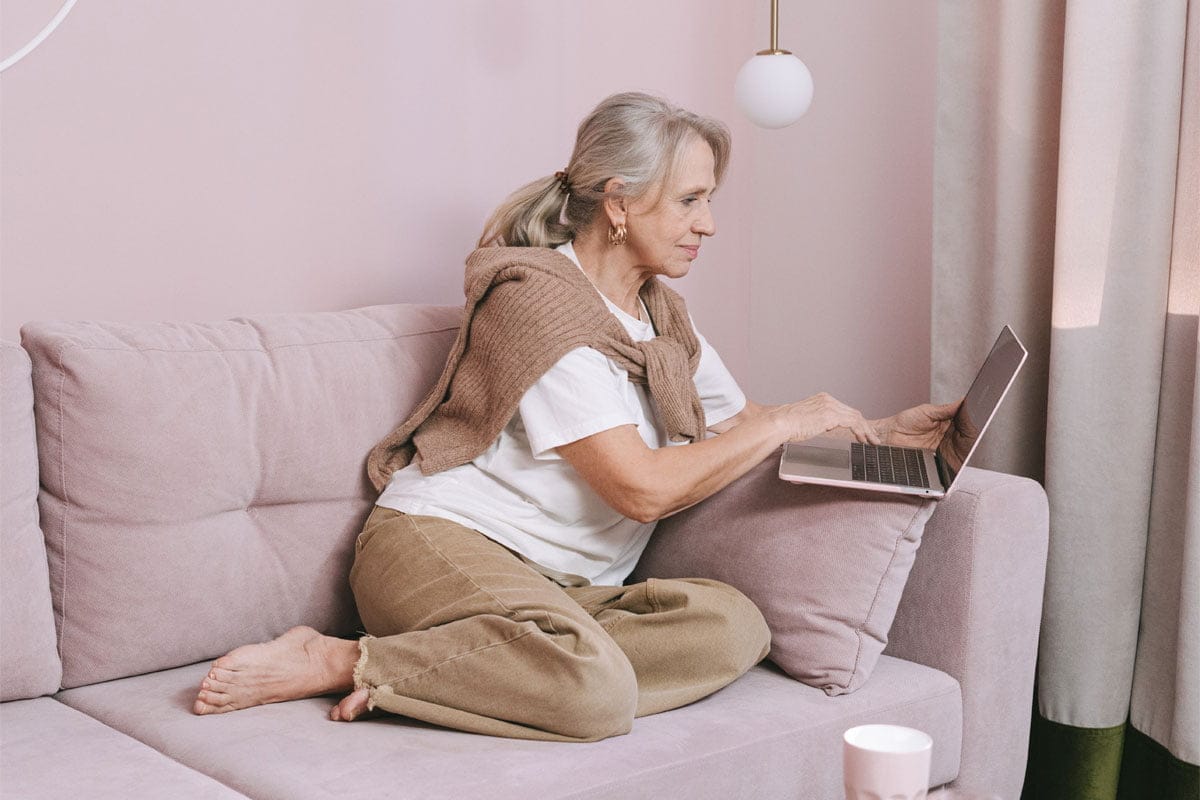While some people have a sophisticated home office setup — you know, with an actual desk and all — many of us are working from tables and couches. The problem? Too much sitting can take a toll on the body making stretches very important.
For instance, a couch lacks the support for proper posture, says Jaclyn Fulop, MSPT, a board-licensed physical therapist and founder of Exchange Physical Therapy Group.
“Using a laptop while sitting on a couch causes the shoulders to slouch forward,” Fulop explains. “Over time, this forward head posture can lead to muscle imbalances as the body tries to adapt and find ways to hold the head up. Some muscles become elongated and weakened, whereas other muscles become shorter and tighter, resulting in neck pain, herniated discs, pinched nerves, and poor posture.” Sitting on a couch for prolonged periods can also flatten the lumbar curvature and shorten the hip flexors and IT bands, increasing the likelihood of lower back pain, she adds.
The best way to prevent pain and discomfort is by purchasing an office chair and working from a table with your screen at eye level. Fulop recommends getting one with adjustable features like a backrest, armrests, and lumbar support. Otherwise, a dining room chair brings you closest to the proper ergonomic posture, she says. But if you must continue to work from your couch, keep your back straight, using pillows to support the spine, and feet flat on the floor with the hips and knees positioned at 90 degrees.
And perhaps most importantly, frequent stretching is a must if you’re sitting all day. “Proper stretching will improve posture, align the shoulders, and restore the curvature in the spine while preventing musculoskeletal imbalances,” says Fulop. “I always tell my patients that they should adjust their position every 20 minutes, even if it is just to stand up and stretch the body backwards.” That’s because a muscle knot can take 20 minutes to form if the body stays in a static position.
So, to get started, Fulop shares the four sitting stretches she prescribes to prevent neck, shoulder, and lower back discomfort when working from home.
Upper Trapezius Stretch
This is an excellent stretch for anyone who has been sitting all day, as it relieves tightness in the upper back, arms, and neck. Sit up straight in a chair with your head and neck in a neutral position, ears in line with your shoulders, and hold the edge of your chair with your right hand. Tuck your chin in slightly, grab the right side of your head with your left hand, and gently pull your head to the left while looking straight ahead. Use gentle pressure to increase the stretch, Fulop says, but don’t force your head into position. Hold for 30 to 60 seconds, then return your head and neck to a neutral position. Do two repetitions on each side.
Seated Levator Scapulae Stretch
“This is one of most effective upper back stretches, since the Levator scapulae muscle gets very tight from texting and prolonged desk work,” says Fulop. Take a seat and grab the bottom of your chair with your right hand. Bring your chin in toward your chest and rotate your head towards the left shoulder. Then, using your left arm, gently push your head down toward your left armpit until you feel a slight stretch along the right side of your neck. Hold this position for 15 to 20 seconds before returning to a neutral position. Do three repetitions on each side.
Doorway Pectoral Stretch
Opening up the front of the body with this stretch will help increase the range of motion in the shoulders while releasing any tension in your upper back. To start, stand in an open doorway, and raise each arm up to the side, bent at 90-degree angles with palms resting on the door frame. Standing upright, slowly step forward with one foot. Don’t allow your body to lean forward, Fulop notes, explaining that you should feel the stretch in your shoulders and chest. Hold for 30 seconds; then step back and relax.Repeat three times.
Hip Flexor Stretch
This stretch will combat tight hips caused by sinking into the couch or sitting crisscrossed, says Fulop. From a kneeling lunge, press your hands into your front thigh and let your pelvic floor sink downward while engaging the glutes of your rear leg. Hold for five long, deep breaths, she says, using exhalations to try and sink closer to the floor. Repeat on the other side.
8 Most Comfortable Bras To Wear At Home
While these stretches will certainly help if you’ve been sitting on a couch all day, to avoid musculoskeletal problems, it’s important to stay in a proper ergonomic position when working from home, Fulop emphasizes. Pay attention to your posture, no matter your setup, and don’t forget to stand up and readjust your position. The more regularly you stretch or move about, the better it is for your body, she adds.

